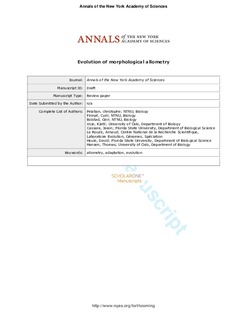| dc.contributor.author | Pelabon, Christophe | |
| dc.contributor.author | Firmat, Cyril Joel Patrick | |
| dc.contributor.author | Bolstad, Geir Hysing | |
| dc.contributor.author | Voje, Kjetil L. | |
| dc.contributor.author | Houle, David | |
| dc.contributor.author | Cassara, Jason | |
| dc.contributor.author | Le Rouzic, Arnaud | |
| dc.contributor.author | Hansen, Thomas F | |
| dc.date.accessioned | 2017-11-03T07:21:39Z | |
| dc.date.available | 2017-11-03T07:21:39Z | |
| dc.date.created | 2014-09-16T09:35:37Z | |
| dc.date.issued | 2014 | |
| dc.identifier.citation | Annals of the New York Academy of Sciences. 2014, 1320 (1), 58-75. | nb_NO |
| dc.identifier.issn | 0077-8923 | |
| dc.identifier.uri | http://hdl.handle.net/11250/2463867 | |
| dc.description.abstract | Morphological allometry refers to patterns of covariance between body parts resulting from variation in body size. Whether measured during growth (ontogenetic allometry), among individuals at similar developmental stage (static allometry), or among populations or species (evolutionary allometry), allometric relationships are often tight and relatively invariant. Consequently, it has been suggested that allometries have low evolvability and could constrain phenotypic evolution by forcing evolving species along fixed trajectories. Alternatively, allometric relationships may result from natural selection for functional optimization. Despite nearly a century of active research, distinguishing between these alternatives remains difficult, partly due to wide differences in the meaning assigned to the term allometry. In particular, a broad use of the term, encompassing any monotonic relationship between body parts, has become common. This usage breaks the connection to the proportional growth regulation that motivated Huxley's original narrow-sense use of allometry to refer to power–law relationships between traits. Focusing on the narrow-sense definition of allometry, we review here evidence for and against the allometry-as-a-constraint hypothesis. Although the low evolvability and the evolutionary invariance of the static allometric slope observed in some studies suggest a possible constraining effect of this parameter on phenotypic evolution, the lack of knowledge about selection on allometry prevents firm conclusions. | nb_NO |
| dc.language.iso | eng | nb_NO |
| dc.publisher | Wiley | nb_NO |
| dc.title | Evolution of morphological allometry | nb_NO |
| dc.type | Journal article | nb_NO |
| dc.description.version | submittedVersion | nb_NO |
| dc.source.pagenumber | 58-75 | nb_NO |
| dc.source.volume | 1320 | nb_NO |
| dc.source.journal | Annals of the New York Academy of Sciences | nb_NO |
| dc.source.issue | 1 | nb_NO |
| dc.identifier.doi | 10.1111/nyas.12470 | |
| dc.identifier.cristin | 1154762 | |
| dc.relation.project | Norges forskningsråd: 196434 | nb_NO |
| dc.relation.project | Norges forskningsråd: 223257 | nb_NO |
| dc.relation.project | Norges forskningsråd: 179569 | nb_NO |
| dc.description.localcode | This is the pre-peer reviewed version of the following article: [Evolution of morphological allometry], which has been published in final form at [http://onlinelibrary.wiley.com/doi/10.1111/nyas.12470/abstract]. This article may be used for non-commercial purposes in accordance with Wiley Terms and Conditions for Self-Archiving. | nb_NO |
| cristin.unitcode | 194,66,10,0 | |
| cristin.unitname | Institutt for biologi | |
| cristin.ispublished | true | |
| cristin.fulltext | preprint | |
| cristin.qualitycode | 1 | |
